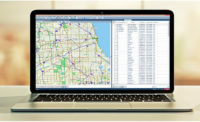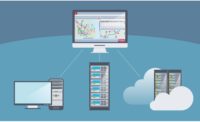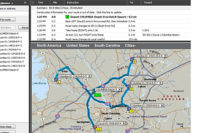How routing, scheduling systems help deliver chilled foods

Whether it’s ambient, chilled or frozen, food needs to be transported as quickly as possible to ensure that stores are able to meet the continuous customer demand. Transportation managers planning on behalf of food manufacturers, processors or distributors need to plan carefully, so that deliveries arrive safely, cost efficiently and on time.
Food products also require a variety of different delivery cycles. Refrigerated foods, such as milk, typically arrive at convenience stores in the morning in time for customers’ AM coffee, while meat can be delivered later in the day in time for dinner. Retailers usually have limited storage for chilled goods, resulting in the need for multiple deliveries each day.
Delivering the right volume of product at the right time of day is no easy task. It requires transportation operators to consider factors such as the availability of the appropriate temperature-controlled vehicles, unloading time required, delivery time restrictions, journey times and Hours of Service restrictions for drivers. With this level of complexity, it is impossible to plan routes and schedules for hundreds of drivers making multiple deliveries each day without a route planning system.
For example, one of our customers, a chilled dairy food producer and distributor, uses a routing and scheduling system to daily plan and optimize same-day direct-to-store deliveries with narrow 2-hour windows in the morning and afternoon the following day. The company modeled their 4,500 weekly deliveries across hundreds of routes with more than 250 individual delivery windows using “what-if” scenarios to improve efficiencies. By standardizing some of the time windows at a regional level while combining deliveries with time-constrained direct-store deliveries, the company was able to reach a 15% gain in vehicle utilization, a 10% drop in routes per week and improved customer service levels.
Routing and scheduling software creates more cost-efficient routes, helping stores keep prices to a minimum, but it also benefits store operations. Here is how such systems can enable stores to minimize disruption when deliveries arrive and enable more rapid replenishment of stock:
Improve on-time delivery to stores. The ability to plan more accurately, accounting for actual road speeds and a feasible route for each vehicle type, ensures that planned arrival times are met, allowing store managers to plan their day more efficiently.
Improve communication on the day. The ability to compare a transportation plan with real-time tracking data enables store managers to view the up-to-date status of each of their deliveries. This helps ensure that staff with the right skills are available when the delivery arrives.
Keep shelves stocked with fresh goods. With Paragon’s advanced routing functionality, transportation planners can ensure fresh produce is delivered before frozen or ambient product, so that staff can fully stock shelves before customers arrive.
Be respectful of your neighbors. Deliveries to stores located in urban areas need to factor in the feelings of local residents. Avoiding school drop-off/pick-up times, early mornings or late evenings can all make planning feasible routes more manual and time consuming. Automatically applying route rules at specific times of the day, week or month by vehicle type ensures residents are not disturbed and local authority restrictions are respected.
Manage deliveries and collections in the same plan. If vehicles are collecting packaging for recycling, then transportation planners can use a route planning tool to ensure that collections can be scheduled on return journeys, thus maximizing the use of drivers and vehicles and making sure store operations run as smoothly as possible. It is also possible to incorporate supplier collections into the schedule to further reduce food miles.
Large grocery store chains need to accommodate the different profiles of their store locations in the planning process. For example, the delivery parameters for stores located in rural and urban areas will be very different.
Most large grocery stores are located in urban areas. In today’s market, traffic within cities is becoming more and more congested. When shipping refrigerated and frozen foods to these areas, routes need to be planned to avoid congestion, but also to avoid local restrictions. Some routing and scheduling systems offer a calendar-like functionality to create routes that comply with time and day-related local, state and national regulations and road closures resulting from major public events. Rules that automatically apply legitimate route deviations at specific times of the day, week or month by truck type can be added to transportation plans, so that drivers can better meet delivery schedules.
Many convenience stores and smaller grocery outlets are located in rural areas. Deliveries are usually far and wide apart for each truck route. Time-sensitive deliveries for refrigerated and frozen foods coordinate mileage with timeliness to keep foods from spoiling. Often, distributors to these locations will use trucks that are compartmentalized into multiple temperature zones. Others will put ambient products in with refrigerated foods if a short trip ensures that the products don’t freeze.
Meeting the challenges of planning the transportation of chilled foods can be quite daunting, especially if done manually with spreadsheets. Transport planners are finding that automating their delivery schedules with routing and scheduling systems not only reduces planning time, but also allows them to incorporate the almost unlimited variables their operations face each day.
Looking for a reprint of this article?
From high-res PDFs to custom plaques, order your copy today!





